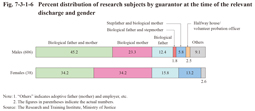2 Situation while in juvenile training schools and parole supervision
(1) Term at juvenile training schools
The average term at juvenile training schools of the research subjects was 151 days with those that received general short-term treatment programs, 78 days with those that received special short-term treatment programs, and 376 days with those that received long-term treatment programs. 23 (5.8%) of those that received long-term treatment programs were held at juvenile training schools for longer than 540 days (approximately 1.5 years).
(2) Acquisition of qualifications/licenses in juvenile training schools
Table 7-3-1-5 shows the status with qualifications/licenses being acquired by the research subjects in juvenile training schools. The percentage of research subjects that acquired qualifications/licenses related to the vocational guidance courses individually assigned to them was 42.1% and that not related to the vocational guidance course 55.7%. The percentage of those that acquired some type of qualification/license while in juvenile training schools was 77.8%.
Table 7-3-1-5 Qualifications/licenses acquired in juvenile training school by gender
(3) Places to return to after the relevant discharge
Fig. 7-3-1-6 shows the percent distribution of the research subjects by guarantor at the time of their relevant discharge and gender. Of 621 research subjects whose guardians were their biological fathers and mothers, biological mothers, biological fathers, biological fathers and stepmothers, or stepfathers and biological mothers at the time of the index offense, 49 (7.9%) returned to halfway houses, etc.
Fig. 7-3-1-6 Percent distribution of research subjects by guarantor at the time of the relevant discharge and gender
(4) Reason for termination of parole supervision
Fig. 7-3-1-7 shows the percent distribution of the research subjects by the reason for their termination of parole supervision and gender. Most of them had their parole supervision terminated upon completion of the term with respect to both males and females. The proportion of those whose parole supervision was terminated by revocation of protective measures was 7.8% (total of males and females). Examining the situation with the total juvenile training school parolees in 2010 (See Fig. 3-1-5-7) revealed that the proportion of those whose parole supervision terminated upon completion of the term was higher with the research subjects. This is considered to be due to the fact that the age of the research subjects at the time of their relevant discharge was 18 or 19 and the term of their parole supervision was short.
Fig. 7-3-1-7 Percent distribution of research subjects by reason for termination of parole supervision and gender
The number of research subjects that were committed to juvenile training schools again due to repeat delinquencies was 64 (10.6%) males and one (2.6%) female.


